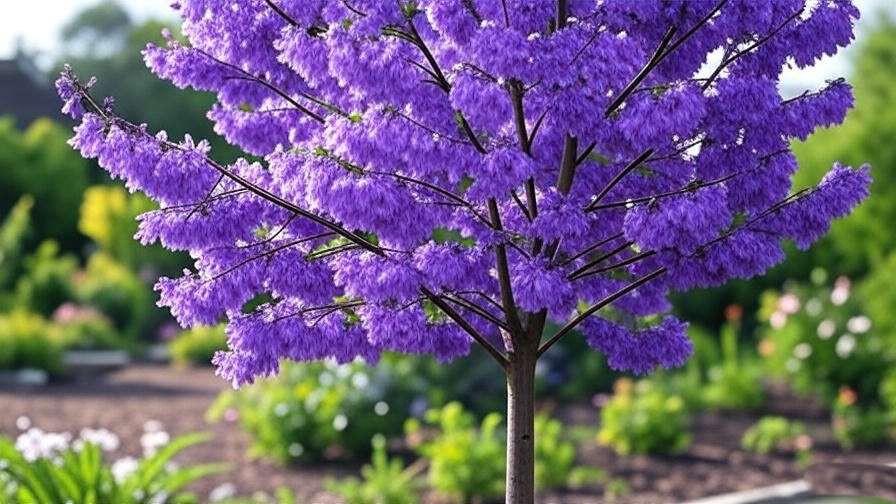Imagine your garden bursting with vibrant purple blossoms, swaying gently in the spring breeze—a sight that transforms your outdoor space into a living masterpiece. Spring tree purple flower varieties, like jacarandas, redbuds, and wisterias, are the crown jewels of any landscape, but their stunning blooms require dedicated care to thrive. Whether you’re a seasoned gardener or a beginner, mastering the art of nurturing these trees can elevate your garden’s beauty and ensure years of breathtaking displays. In this comprehensive guide, we draw on decades of horticultural expertise to provide you with actionable, expert-driven tips to grow and maintain healthy purple-flowering trees. From planting to pest control, you’ll learn everything needed to solve common challenges and achieve vibrant blooms. 🌺
Understanding Spring Tree Purple Flower Varieties 🌺
Popular Purple-Flowering Trees for Spring
Purple-flowering trees are a gardener’s dream, adding dramatic color and structure to landscapes. Some of the most beloved species include:
- Jacaranda (Jacaranda mimosifolia): Known for its cascading clusters of lavender-blue flowers, blooming in late spring. Ideal for USDA zones 9–11, it grows up to 40 feet tall.
- Eastern Redbud (Cercis canadensis): Produces delicate pinkish-purple blooms in early spring, perfect for zones 4–9, reaching 20–30 feet.
- Empress Tree (Paulownia tomentosa): Features fragrant, trumpet-shaped purple flowers, thriving in zones 5–9, with rapid growth to 50 feet.
- Wisteria (Wisteria sinensis): Though often grown as a vine, it can be trained as a tree, offering drooping purple flower clusters in zones 5–9.
Each species has unique bloom times, sizes, and care needs, making them versatile for various garden styles. Their popularity stems from their ability to create focal points and attract pollinators like bees and butterflies. 🐝
Choosing the Right Tree for Your Garden
Selecting the perfect purple-flowering tree starts with understanding your garden’s conditions. Consider:
- Climate: Check your USDA hardiness zone to ensure compatibility. For example, jacarandas thrive in warmer climates, while redbuds tolerate colder regions.
- Soil Type: Most purple-flowering trees prefer well-drained, loamy soil with a pH of 6.0–7.0.
- Space: Account for mature tree size to avoid overcrowding. A jacaranda needs more room than a compact redbud.
- Aesthetic Goals: Decide if you want a single statement tree or a row for privacy.
| Tree Species | Bloom Time | Mature Height | Hardiness Zones | Sunlight Needs |
| Jacaranda | Late Spring | 25–40 ft | 9–11 | Full Sun |
| Eastern Redbud | Early Spring | 20–30 ft | 4–9 | Full Sun/Part Shade |
| Empress Tree | Mid-Spring | 30–50 ft | 5–9 | Full Sun |
| Wisteria (Tree Form) | Early–Mid Spring | 15–25 ft | 5–9 | Full Sun |
Expert Tip: Contact your local cooperative extension service for region-specific advice on tree selection. This ensures your choice aligns with local climate and soil conditions, boosting long-term success. 🌱
Planting Your Spring Tree Purple Flower 🌱
Best Time to Plant
Timing is critical for establishing a healthy tree. The best seasons for planting purple-flowering trees are early spring or fall, when cooler temperatures and moderate rainfall support root development. Avoid planting during extreme heat or frost, as these stress young trees. For example, planting a jacaranda in early spring allows it to establish before summer heat, while fall planting suits redbuds in colder zones. Check local weather patterns to pinpoint the ideal window. 📅
Site Selection and Soil Preparation
Choosing the right location sets the stage for vibrant blooms. Follow these steps:
- Sunlight: Most purple-flowering trees need full sun (6–8 hours daily) for optimal flowering. Redbuds tolerate partial shade but bloom best with ample light.
- Drainage: Ensure the site has well-drained soil to prevent root rot. Test drainage by digging a 12-inch hole, filling it with water, and checking if it drains within 4–6 hours.
- Space: Account for the tree’s mature spread. A jacaranda may need 30 feet of clearance, while a redbud requires less.
- Soil Testing: Use a soil test kit to check pH and nutrient levels. Amend acidic soils with lime or alkaline soils with sulfur to reach the ideal 6.0–7.0 pH range.
Step-by-Step Guide to Soil Preparation:
- Dig a hole twice as wide and as deep as the root ball.
- Mix native soil with compost (50:50 ratio) to improve fertility and drainage.
- Add a layer of mulch around the base (2–3 inches) to retain moisture, keeping it 2 inches from the trunk.
Planting Techniques for Success
Proper planting ensures your tree thrives. Follow these steps:
- Dig the Hole: Make it wide but not deeper than the root ball to prevent settling.
- Place the Tree: Set the tree so the root collar (where roots meet trunk) is level with or slightly above ground.
- Backfill: Fill the hole with the soil-compost mix, tamping gently to remove air pockets.
- Water: Soak the soil thoroughly after planting, providing 5–10 gallons for a young tree.
- Stake if Needed: Use stakes for tall or windy sites, but remove them after one year to encourage strong roots.
Common Mistake to Avoid: Planting too deeply can suffocate roots, while overwatering can cause rot. Check soil moisture before watering again. 💧
Essential Care Tips for Vibrant Blooms 🌼
Watering Needs
Watering is critical, especially during the first two years. Young trees need consistent moisture to establish roots, while mature trees are more drought-tolerant. General guidelines:
- Young Trees: Water 2–3 times per week, providing 1–2 inches of water each time. Use a soaker hose for deep watering.
- Mature Trees: Water weekly during dry spells, ensuring soil stays moist but not soggy.
- Signs of Imbalance:
- Overwatering: Yellowing leaves, soft roots, or fungal growth.
- Underwatering: Wilting, dry leaves, or stunted growth.
Pro Tip: Apply a 2–3-inch layer of organic mulch (e.g., wood chips) around the tree base to retain moisture and regulate soil temperature. Avoid piling mulch against the trunk to prevent rot. 🌿
Fertilizing for Healthy Growth
Fertilization boosts bloom production and overall health. Use a balanced fertilizer with a low-nitrogen, high-phosphorus formula (e.g., 10-20-10) to encourage flowering over leaf growth.
- Timing: Fertilize in early spring before blooms form and again in mid-summer for young trees. Mature trees may need only one annual application.
- Application: Spread granular fertilizer evenly around the drip line (the area under the canopy’s edge), then water thoroughly.
- Organic vs. Synthetic:
- Organic: Compost or fish emulsion provides slow-release nutrients and improves soil health.
- Synthetic: Offers quick results but requires careful application to avoid burn.
Expert Insight: Test soil annually to avoid over-fertilizing, which can reduce blooms and harm roots. University extension services often offer affordable soil testing. 🌱
Pruning for Shape and Bloom Enhancement
Pruning shapes the tree and encourages prolific flowering. Each species has specific needs:
- Jacaranda: Prune in late winter to remove dead or crossing branches, enhancing airflow.
- Redbud: Prune after flowering to maintain shape and remove suckers.
- Wisteria: Requires heavy pruning in late winter and light trimming in summer to control growth and boost blooms.
How to Prune:
- Use clean, sharp tools (bypass pruners or loppers).
- Remove dead, damaged, or diseased branches first.
- Thin crowded areas to improve light penetration.
- Make cuts at a 45-degree angle just above a bud or branch collar.
Safety Note: Wear gloves and safety glasses, and avoid pruning near power lines. For large trees, hire a certified arborist. ✂️
Visual Aid: [Insert placeholder for pruning diagram showing correct cut angles for jacaranda and redbud.]
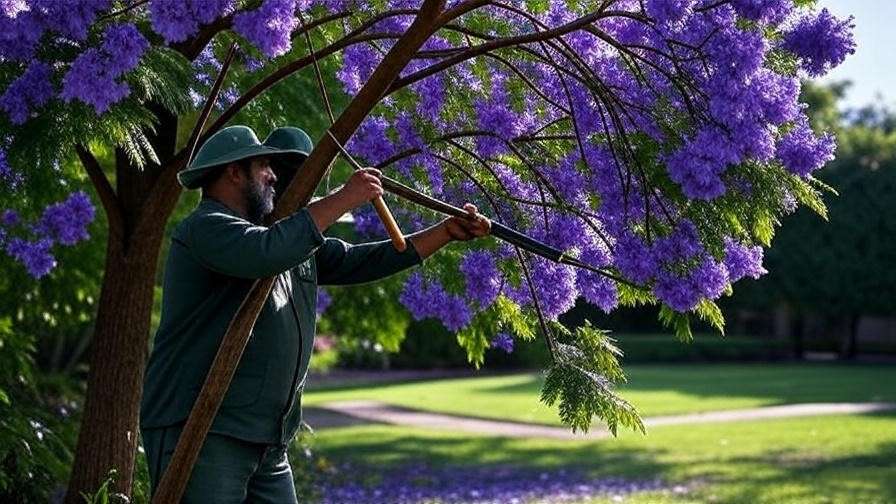
Protecting Your Tree from Pests and Diseases 🐞
Common Pests Affecting Purple-Flowering Trees
Purple-flowering trees, like jacarandas and redbuds, can attract pests that threaten their health and bloom quality. Identifying and managing these pests early is key to maintaining vibrant trees. Common culprits include:
- Aphids: Small, sap-sucking insects that cause curled leaves and sticky residue. They can also transmit plant viruses.
- Scale Insects: Tiny, immobile pests that form hard shells on branches, weakening the tree by draining sap.
- Caterpillars: Leaf-eating larvae that can defoliate young trees if left unchecked.
Control Methods:
- Organic: Spray neem oil or insecticidal soap to suffocate aphids and scales. Introduce beneficial insects like ladybugs, which are natural aphid predators.
- Chemical: Use targeted pesticides (e.g., imidacloprid) for severe infestations, following label instructions to avoid harming pollinators.
- Monitoring: Inspect leaves and stems weekly during spring and summer for early signs of pests.
Prevention Tip: Plant companion species like marigolds or lavender near your tree to deter pests naturally. Regular cleaning of fallen leaves also reduces pest habitats. 🌱
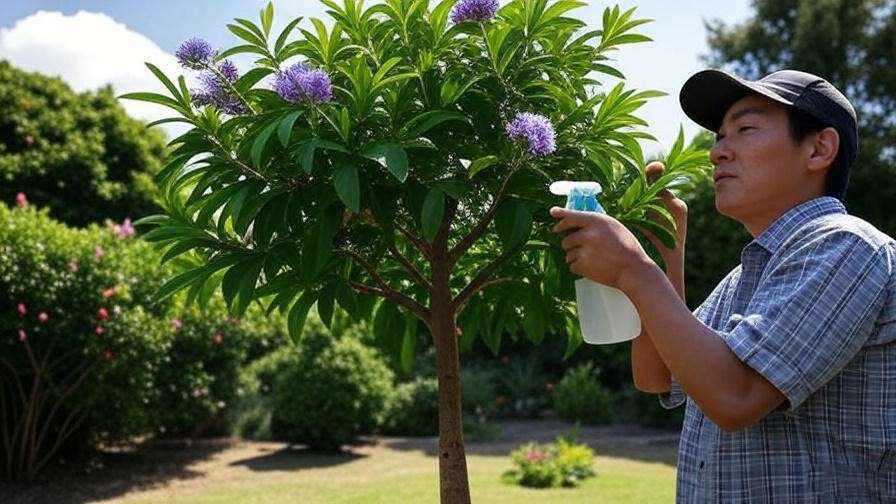
Diseases to Watch For
Fungal and bacterial diseases can compromise the health of purple-flowering trees, especially in humid or poorly drained conditions. Common issues include:
- Powdery Mildew: Appears as white, powdery spots on leaves, often in shaded or humid areas. Treat with fungicides or improve air circulation through pruning.
- Root Rot: Caused by overwatering or poor drainage, leading to wilting and soft, discolored roots. Prevent by ensuring proper drainage and avoiding waterlogged soil.
- Verticillium Wilt: A soil-borne fungus causing leaf yellowing and branch dieback. Remove affected branches and avoid planting susceptible species in infected soil.
Symptoms and Treatments:
- Powdery Mildew: Apply sulfur-based fungicides and increase sunlight exposure.
- Root Rot: Reduce watering, improve drainage, and apply fungicides if caught early.
- Verticillium Wilt: No cure exists, but pruning infected areas and maintaining tree vigor can help.
Case Study: A gardener in Florida noticed their jacaranda’s leaves yellowing despite regular care. After consulting a local extension service, they identified root rot due to poor drainage. By redirecting irrigation and adding organic matter to improve soil structure, the tree recovered within two seasons. 🩺
Seasonal Care for Long-Term Success 📅
Spring and Summer Maintenance
Spring and summer are active growth periods for purple-flowering trees, requiring attentive care to maximize blooms and health.
- Bloom Monitoring: Check for spent flowers and deadhead (remove) them to encourage new blooms, especially for wisteria. Avoid heavy pruning during bloom season to preserve flowers.
- Watering Adjustments: Increase watering frequency during hot, dry spells, ensuring deep soaking (1–2 inches per session) for established trees.
- Fertilization: Apply a high-phosphorus fertilizer in early spring to boost flower production. Avoid late-summer feeding to prevent tender growth before winter.
Checklist:
- Inspect for pests weekly.
- Mulch to maintain soil moisture.
- Stake young trees if needed to protect against summer storms.
Fall and Winter Preparation
Preparing your tree for dormancy ensures it emerges strong in spring. Focus on:
- Frost Protection: For young trees in zones 4–7 (e.g., redbuds), wrap trunks with burlap or tree wraps to shield against freezing temperatures. Jacarandas in zones 9–11 need less protection but benefit from mulch.
- Mulching: Apply a 3–4-inch layer of organic mulch (e.g., bark or straw) around the base to insulate roots. Keep mulch 2 inches from the trunk to prevent rot.
- Watering: Reduce watering as growth slows, but ensure soil doesn’t dry out completely in milder climates.
Checklist:
- Remove fallen leaves to prevent fungal buildup.
- Prune lightly in late fall to remove dead wood.
- Check stakes and ties to ensure they’re secure but not constricting.
Expert Tip: In colder regions, consider planting hardier species like redbuds over jacarandas to minimize winter damage. Local nurseries can recommend zone-specific varieties. ❄️
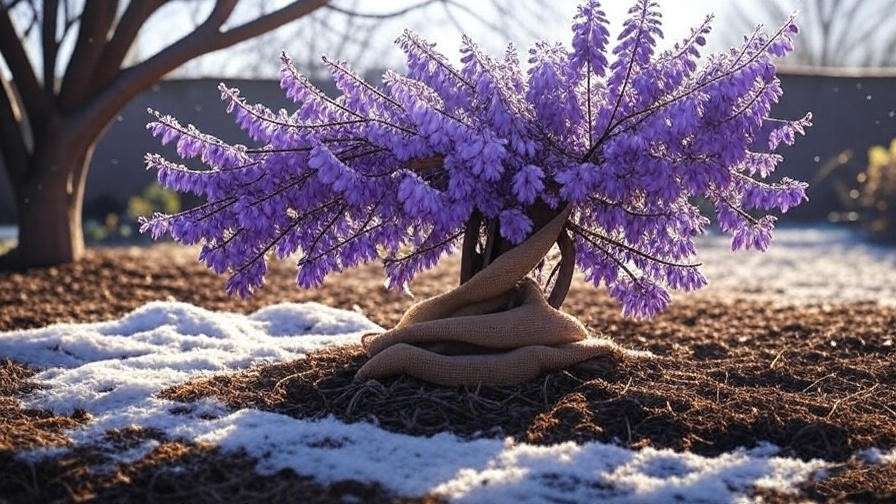
Enhancing Your Garden with Spring Tree Purple Flowers 🌿
Companion Planting Ideas
Pairing purple-flowering trees with complementary plants enhances both aesthetics and ecosystem health. Ideal companions include:
- Lavender: Its purple blooms echo the tree’s flowers and deter pests like aphids.
- Salvia: Adds vibrant color and attracts pollinators, supporting tree health.
- Low-Growing Shrubs: Boxwood or dwarf azaleas create a tidy understory, reducing weed competition.
Benefits:
- Pollinator attraction (bees, butterflies).
- Pest deterrence through aromatic plants.
- Visual harmony with coordinated color palettes.
Example: Plant a redbud with a border of lavender and white alyssum for a stunning spring display that’s low-maintenance and pollinator-friendly. 🐝
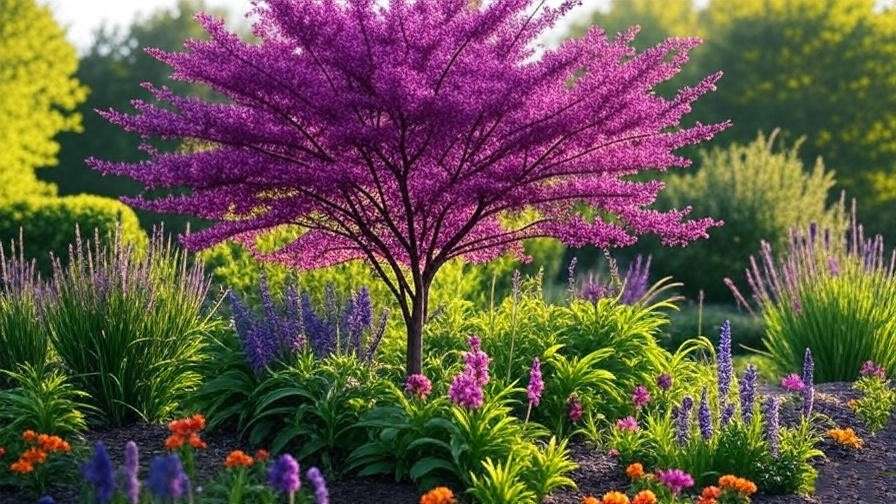
Landscaping Tips for Maximum Impact
Purple-flowering trees can transform your garden into a showstopper. Design ideas include:
- Focal Point: Plant a jacaranda as a standalone centerpiece in a lawn or courtyard for dramatic effect.
- Privacy Screen: Use a row of redbuds along a property line to create a natural barrier with vibrant blooms.
- Mixed Borders: Combine wisteria (trained as a tree) with evergreen shrubs for year-round structure and seasonal color.
Inspiration: A California homeowner used a jacaranda flanked by low-growing salvia and ornamental grasses to create a vibrant, drought-tolerant front yard. [Insert placeholder for alt-text-optimized image of a purple tree landscape.] 🌄
Troubleshooting Common Issues ⚠️
Why Isn’t My Tree Blooming?
Lack of blooms can frustrate gardeners, but common causes are fixable:
- Insufficient Sunlight: Most purple-flowering trees need full sun. Relocate container-grown trees or thin overhead branches to increase light.
- Improper Pruning: Pruning at the wrong time (e.g., before bloom season) removes flower buds. Follow species-specific pruning schedules.
- Nutrient Deficiencies: Low phosphorus or potassium can reduce blooms. Apply a balanced fertilizer (e.g., 10-20-10) in early spring.
Diagnostic Process:
- Check sunlight exposure (6–8 hours daily).
- Test soil for nutrient levels and pH.
- Review pruning history and adjust timing.
Solution: For a non-blooming redbud, apply a phosphorus-rich fertilizer and ensure proper pruning after flowering. Blooms may return the next season. 🌸
Addressing Leaf Drop or Discoloration
Leaf issues often signal stress. Common causes and fixes:
- Environmental Stress: Drought, heat, or poor drainage can cause wilting or yellowing. Adjust watering and improve soil drainage.
- Pests: Aphids or scales may cause leaf curl or spots. Treat with neem oil or insecticidal soap.
- Diseases: Fungal infections like powdery mildew cause discoloration. Apply fungicides and improve air circulation.
When to Call an Arborist: If leaf drop persists or branches die back, consult a certified arborist to diagnose severe issues like verticillium wilt. 🩺
Quick Fix Guide:
- Water deeply during dry spells.
- Inspect for pests and treat promptly.
- Prune affected areas to prevent disease spread.
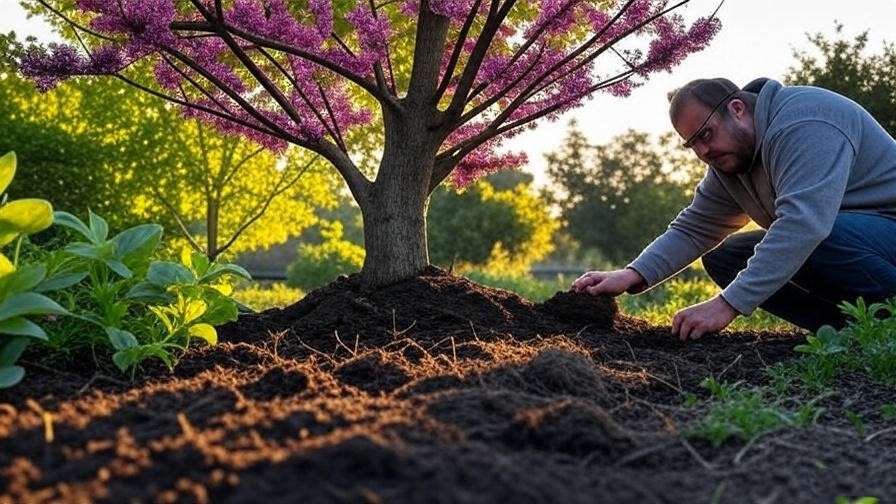
FAQs About Spring Tree Purple Flower Care ❓
Q1: How long does it take for a purple-flowering tree to bloom after planting?
A: Most trees, like redbuds, bloom within 2–3 years if planted correctly. Jacarandas may take 5–7 years for full blooms. Ensure proper care to speed up establishment.
Q2: Can these trees grow in containers or small spaces?
A: Yes, wisteria trained as a tree or dwarf redbud varieties can thrive in large containers. Use well-drained soil and water consistently.
Q3: What’s the best way to propagate purple-flowering trees?
A: Redbuds and jacarandas can be propagated via seeds or cuttings, but cuttings are faster. Soak seeds overnight or take softwood cuttings in spring for best results.
Q4: Are purple-flowering trees safe for pets and children?
A: Most are non-toxic, but wisteria seeds and pods are toxic if ingested. Keep pets and kids away from fallen pods and monitor play areas.
Q5: How do I protect my tree from extreme weather?
A: Use mulch and tree wraps for cold snaps, and stake young trees during storms. For heatwaves, provide extra water and shade cloth for young trees.
Conclusion
Purple-flowering trees like jacarandas, redbuds, and wisterias bring unmatched beauty to spring gardens, but their vibrant blooms depend on proper care. By selecting the right species, planting correctly, and following expert care tips, you can enjoy stunning displays year after year. This guide equips you with the knowledge to tackle common challenges, from pest control to pruning, ensuring your trees thrive. Start your purple tree journey today and share your blooms with our community using #PurpleTreePride! 🌳

